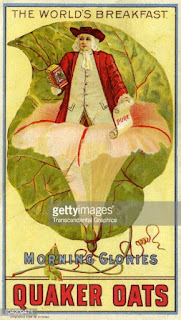I woke up, as most mornings, with all the sincerity in the world to help myself to a cup of tea. I filled up the kettle, put it on the stove, and-
I couldn't do it. I couldn't let another lick of heat into this cruel, hot world.
Our stove is gas, but the majority of cooking throughout history has gone on either in a range (a solid-fuel burning stove) or a massive hearth fire. These fires also double as central heating, and on a day like today, I'm sure there would have been at least a few for whom it simply couldn't be borne.
But when breakfast is bacon and eggs, what's a gal to do? Resisting the urge to go get a shave ice (snow cones are period from the 1850s, with shavers being patented in the 1890s and commercial selling of at-home shavers beginning in 1919), I settled for a bowl of cold milk and some cereal.
When on earth do we get cereal, you ask. Well, I'll tell you.
The first dry cereal is commercially sold in 1863 as "Granula". It isn't that popular, as to be eaten it must be soaked overnight, at which point the consistency is somewhere between soggy cereal and porridge. Grits at this point are considered outside the southern United States to be food for horses- men eat meat in the morning!
In 1877, Ferdinand Schumacher, who had founded an oat products company in 1854, adopts the Quaker as his symbol. The cereal "movement" is considered one for health and, very often, morality.
Wheatena, invented by George H. Hoyt, is the first cereal sold in boxes. Previously it had been sold by weight from barrels by regular grocers.
The American Cereal Company is founded in 1888 from an amalgam of smaller companies.
John Harvey Kellogg patents in 1891 and launched in 1895 "cornflakes". Originally used as a health food by Kellogg at his Health Reform Institute, their blandness was believed to "discourage the passions which lead to autoeroticism".
In 1898, Charles Post, a patient of Kellogg's, introduces Grape Nuts as the breakout product for his own cereal company.
In 1900, Quaker Oats grosses $10 M in annual sales.
John Kellogg's brother William buys the rights to Cornflakes from his brother in 1906 and begins his own venture in the Kellogg Toasted Corn Flake Company.

He adds sugar, and focuses on taste- his signature becomes the company trademark.
Meanwhile, British brands like Force and Golfer are flourishing across the pond.

While Kellogg has always been a popular brand, there were the lesser-knowns, as well.
And, my personal favorite- advertising at its finest.
So next time it's hotter than the hobs, and it's just too hot for that fry-up, crack out the corn flakes and have a nice, cold, period breakfast!














The name of Grape-nuts always puzzled me as a child. They don't taste like grapes and they don't have any nuts! I think the epiphany finally hit me this year, when I was eating grapes that had seeds in them: the little granules of cereal look like grape seeds! Perhaps this was always obvious to you, but it was news to me! :-). I love your blog, it's fascinating!
ReplyDeleteEmily Barry